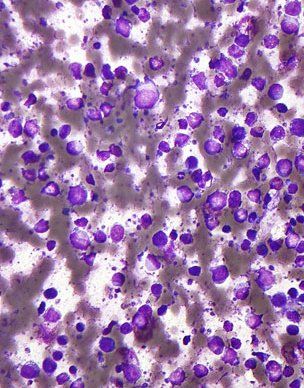Regimen Shows Promise for Lymphoma Patients With Cardiac Conditions
A new phase II trial found that a regimen containing rituximab, gemcitabine, cyclophosphamide, vincristine, and prednisolone is active and reasonably safe in patients with diffuse large B-cell lymphoma and coexisting cardiac disease.
Micrograph of DLBCL, lymph node FNA specimen, field stain; source: Nephron, Wikimedia Commons

Patients with diffuse large B-cell lymphoma (DLBCL) and coexisting cardiac disease represent a treatment challenge, as they are often ineligible to receive anthracycline-containing chemotherapy regimens. A new phase II trial found that a regimen containing rituximab, gemcitabine, cyclophosphamide, vincristine, and prednisolone (R-GCVP) is active and reasonably safe in this patient population.
DLBCL is the most common non-Hodgkin lymphoma, and its incidence increases with age. Thus, as the population ages, more and more patients will present with DLBCL and comorbidities, including cardiovascular issues. Those patients are often excluded from studies involving the standard first-line treatment for DLBCL, which includes the use of doxorubicin, a drug known to carry increased risk of cardiac toxicity. The new study, results of which were published online ahead of print in November in the Journal of Clinical Oncology, removed doxorubicin and added gemcitabine to the standard regimen.
The study enrolled 62 patients with advanced DLBCL considered unfit for anthracycline-containing chemotherapy; 61 eventually received the new R-GCVP regimen. Twenty-seven patients (43.5%) had left ventricular ejection fraction (LVEF) of 50% or less, and the remainder had borderline LVEF between 50% and 55% as well as cardiac risk factors including ischemic heart disease, diabetes, or hypertension.
A total of 38 patients (61.3%) achieved some degree of disease response; 18 of those had a complete response, six had an unconfirmed complete response, and 14 had a partial response. The 2-year progression-free survival rate was 49.8%, and 2-year overall survival was 55.8%. The survival and response rates were slightly better in the group with poorer LVEF.
The researchers described the regimen as relatively well tolerated. Thirty-four patients (55.7% of safety population) did experience a grade 3 or worse hematologic toxicity, and 17 patients (27.9%) had a grade 3 or worse infection. Cardiac events occurred in 15 patients (24.6%), three of which were fatal.
“The issue of treatment-limiting comorbidities will become more critical in future studies as the number of elderly patients with DLBCL increases as a result of changing demographics,” the authors wrote. “Risk stratification with particular reference to end-organ/system deficits will permit more patients to be treated with curative intent and be entered into relevant clinical trials.” They concluded that further testing of the R-GCVP is warranted based on the phase II results.
Study Details
The median age of patients in the trial was 76.5 years, and patients ranged from 52 to 90 years old. Most of the cohort was male (66.1%), and patients were relatively evenly divided between ECOG performance status scores 0 through 3.
Highlighting Insights From the Marginal Zone Lymphoma Workshop
Clinicians outline the significance of the MZL Workshop, where a gathering of international experts in the field discussed updates in the disease state.